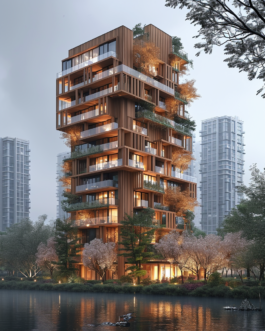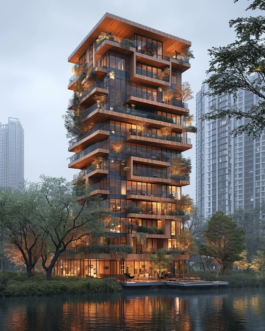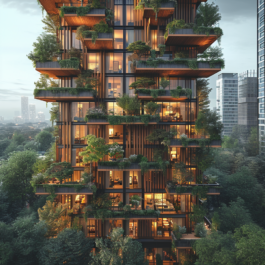Sustainable timber tower architecture
Berlin, Germany, 2023
Timeframe 2023
Type Towers
Concept and Design STERLING PRESSER
Stage Concept design


Sustainable timber tower architecture
Concept, Berlin, Germany, 2023
Sustainable timber tower architecture is an approach that emphasizes the use of timber as the primary structural material in tall buildings, with a strong focus on environmental sustainability and reducing the carbon footprint of the construction industry. Unlike traditional materials like concrete and steel, timber, when sourced from responsibly managed forests, offers a renewable and low-carbon alternative. To achieve sustainable timber tower architecture, several key aspects and considerations come into play. First and foremost is the careful sourcing of materials. The timber used should come from forests certified by organizations such as the Forest Stewardship Council (FSC) or Programme for the Endorsement of Forest Certification (PEFC), ensuring that it is harvested in a sustainable manner that considers factors such as biodiversity, environmental impact, and the well-being of local communities.
In terms of structural design, sustainable timber towers require innovative approaches to ensure they can safely support the height and loads associated with tall buildings. Engineered wood products like cross-laminated timber (CLT), glued laminated timber (glulam), and laminated veneer lumber (LVL) offer strength and stability comparable to conventional materials, enabling the construction of tall and resilient timber structures. Considering the life cycle assessment (LCA) of the building is another crucial element. This involves evaluating the environmental impact of materials, construction processes, and the operational energy efficiency of the building. By taking a holistic approach, sustainable timber tower architecture aims to identify areas for improvement and optimize the building's overall sustainability performance. Fire safety is an essential consideration due to timber's combustible nature. Sustainable timber towers incorporate fire-resistant treatments, fire protection systems, and structural design strategies such as compartmentalization and fire breaks to ensure the safety of occupants and prevent the spread of fire. Energy efficiency is another key aspect. Sustainable timber towers employ design strategies that minimize energy demand, such as passive heating and cooling, natural ventilation, and the use of energy-efficient lighting and appliances. By reducing reliance on fossil fuels, these buildings can significantly reduce their environmental impact and contribute to a more sustainable future. Additionally, sustainable timber towers address aspects of acoustic and thermal performance. Timber's inherent properties contribute to creating comfortable living spaces with good insulation and noise control, enhancing occupant comfort and well-being.
The concept of recyclability and the circular economy is also integrated into sustainable timber tower architecture. Designing buildings with disassembly and recyclability in mind ensures that components can be easily reused or repurposed at the end of their life cycle, minimizing waste and maximizing resource efficiency. Finally, incorporating elements of nature and biophilic design principles is a characteristic of sustainable timber tower architecture. By integrating green spaces, natural light, and views of nature within the building, occupants can experience a stronger connection to the environment, which positively impacts their well-being. In summary, sustainable timber tower architecture combines renewable materials, energy efficiency, and thoughtful design to create tall buildings that are environmentally friendly, aesthetically pleasing, and contribute to a more sustainable future.






Sterling Presser
Architects Engineers PartGmbB
BERLIN, Germany